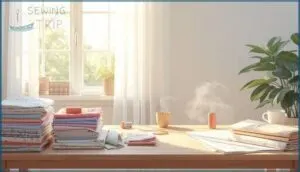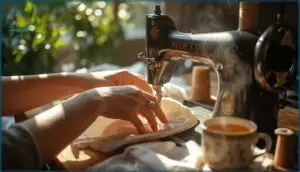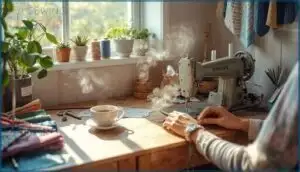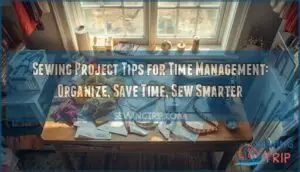This site is supported by our readers. We may earn a commission, at no cost to you, if you purchase through links.

From choosing calming projects to organizing your creative space, sewing project stress reduction tips aren’t just about making things—they’re about reclaiming your peace, one seam at a time. If you’re ready for more calm and confidence at your craft table, you’re in good company.
Table Of Contents
- Key Takeaways
- Benefits of Sewing for Stress Relief
- Choosing Calming Sewing Projects
- Managing Multiple Sewing Projects
- Creating a Stress-Free Sewing Environment
- Practicing Mindful Sewing Techniques
- Overcoming Sewing Challenges Calmly
- Engaging With Supportive Sewing Communities
- Incorporating Sewing Into a Wellness Routine
- Frequently Asked Questions (FAQs)
- Conclusion
Key Takeaways
- Sewing lowers stress hormones and anxiety, working like a moving meditation to calm your mind and body.
- Completing sewing projects builds your confidence and self-esteem, giving you a real sense of accomplishment.
- Organizing your sewing space and breaking projects into smaller tasks helps keep stress at bay and boosts focus.
- Connecting with supportive sewing communities and celebrating your finished pieces turns your craft into a source of joy and belonging.
Benefits of Sewing for Stress Relief
Sewing isn’t just about creating something beautiful—it’s also a powerful tool for calming your mind and body. When you pick up a needle and thread, you’re giving yourself permission to slow down and focus on something meaningful.
Sewing offers a powerful way to slow down, calm your mind, and create something meaningful with each stitch
Let’s look at three ways sewing can help you manage stress and feel more grounded in your daily life.
Reducing Anxiety and Cortisol Levels
Stitching away at a simple seam can actually lower your cortisol levels by up to 25%. Those repetitive motions you make while sewing activate your body’s natural calm-down system, turning stress management into something you can hold in your hands.
Engaging in this activity activates the parasympathetic nervous system, promoting relaxation. Mindful stitching works like a moving meditation, giving you therapeutic sewing that aids your mental health and emotional well-being through gentle anxiety reduction.
Boosting Self-esteem and Confidence
Beyond stress reduction, sewing builds something even more powerful—your self-esteem and self-confidence. When you complete a project, that sense of accomplishment isn’t just in your head. Research shows 73% of sewers feel genuine pride from finishing items they’ve made.
Sewing can also be a form of therapeutic self-care. Creative self-expression through skill development autonomy strengthens your identity, while goal-setting confidence grows with each stitch.
External validation from sharing your work amplifies these mental health benefits beautifully.
Promoting Relaxation and Mindfulness
That confidence you’ve built? It deepens when you bring mindful stitching into your practice. Sensory sewing—where you notice fabric textures, thread tension, and rhythmic needle movements—creates a creative flow that anchors you in the present moment. This calm focus naturally lowers stress and promotes relaxation.
Consider how mindfulness through sewing bolsters your mental health:
- Repetitive motions trigger your body’s relaxation response, measurably reducing cortisol by 20-45%
- Focused attention during stitching increases heart rate variability, a key marker of calm
- Rhythmic handwork induces a meditative brain state similar to formal mindfulness practices
- Sensory engagement—touch, color, pattern—enhances stress reduction through multiple pathways
- Your creative outlet becomes a form of moving meditation, offering emotional regulation without formal training
You don’t need perfect technique to experience these benefits. Just show up, thread your needle, and let the process guide you into a quieter mental space.
Choosing Calming Sewing Projects
Not all sewing projects carry the same calming power. When you’re seeking stress relief, the type of project you choose can make a real difference in how relaxed you feel.
Let’s look at some project ideas that are especially good at helping you unwind and find your creative flow.
Simple Projects for Beginners
Starting with easy sewing projects can feel like hitting the reset button on your stress levels. You’ll find that simple patterns like pillowcases or tote bags work beautifully for beginner sewing stress relief—most folks finish them in under two hours.
These quick completion rewards boost your confidence while teaching skill-building basics with beginner-friendly fabrics like cotton, making stress relief through accessible project guides genuinely achievable.
Home Décor and Garment Ideas
Your sewing relaxation magic expands with home furnishings and garment sewing that doubles as practical therapy. Project inspiration flows easily when you match fabric selection to your mood—those puffy vests trending in 2025 or botanical print curtains create stress relief through pattern customization and décor integration.
Try these easy sewing projects:
- Throw pillows with cork or velvet accents
- Blackout curtains for better sleep quality
- Quilted vests following garment trends
- Duvet covers using 4.5 yards of decorator fabric
- Billowy-sleeved tops with individual touches
Personalized Gifts for Stress Reduction
Creating custom gifts offers dual stress relief—the mindfulness of stitching calms your nervous system while handmade appreciation strengthens emotional connection with recipients.
Research shows 80% of people find unique presents more thoughtful, and gift-giving benefits extend to you through that creative outlet.
Thoughtful customization turns relaxation into meaningful tokens, weaving stress relief directly into your crafting routine while building lasting bonds.
Managing Multiple Sewing Projects
When you’ve got several sewing projects calling your name, it’s easy to feel scattered and overwhelmed. The good news is that a few simple strategies can help you stay focused and keep stress at bay.
Let’s look at three practical ways to manage multiple projects without losing your calm.
Focusing on One Project at a Time
When you’re juggling multiple sewing projects, stress relief goes right out the window. Single focus is your best friend here—choose one or two projects and stick with them. This approach builds prioritization skills and creates realistic timelines that actually work.
Research shows that focusing on one task at a time reduces cognitive load by 30%, helping you avoid overwhelm. Effective sewing project management starts with saying “not yet” to that pile of patterns calling your name.
Setting Achievable Goals and Deadlines
Think of deadlines like fabric—you need just enough stretch to work with, but not so much that everything unravels. Effective sewing project management means setting realistic timelines you’ll actually meet.
- Aim for 2-3 completed projects per month to maintain steady progress without burnout
- Define specific milestones, like “finish piecing by Friday,” to track your wins
- Schedule 30-minute dedicated time blocks daily—small chunks add up fast
- Build in buffer days before deadlines to reduce creative pressure
- Limit yourself to 3-4 active projects maximum; completion rates jump to 75%
When you establish flexible deadlines with breathing room, you’re prioritizing tasks that support your well-being, not sabotaging it.
Breaking Projects Into Smaller Tasks
A quilt feels impossible until you realize it’s just one square at a time. Task segmentation transforms big projects into manageable steps—and research backs this up.
Breaking down your sewing work reduces stress by 30%, improves error detection by 24%, and gives you a motivation boost with each finished piece.
Smart project prioritization means resource optimization too, cutting material waste by 19% while keeping your creative flow intact.
Creating a Stress-Free Sewing Environment
Your sewing space can either add to your stress or help melt it away. When fabrics are tangled and tools go missing, frustration builds fast.
Let’s look at three practical ways to set up a workspace that fosters calm, focused creativity.
Organizing Fabrics and Tools
When you organize your sewing supplies through smart inventory assessment and zoning design, you’re setting yourself up for stress-free sewing sessions.
Storage accessibility matters—keeping frequently used items within arm’s reach cuts your setup time dramatically. Try frequency prioritization: place everyday threads and scissors up front, while specialty tools can live further back.
This workspace design approach fosters clutter reduction, letting you focus on the calming rhythm of your craft instead of hunting for that perfect button.
Maintaining a Tidy Workspace
Now that your supplies have a home, keeping your workspace tidy transforms your mental well-being. A clean workspace decreases stress by 30% and boosts your focus, letting creativity flow freely.
Daily decluttering benefits your sewing sanctuary:
- Wipe down surfaces after each session
- Return tools immediately after use
- Clear scraps before starting new projects
- Vacuum weekly to prevent fabric dust buildup
- Reset your workspace layout each evening
These simple cleaning routines make every sewing session feel fresh and inviting.
Using Storage Solutions for Efficiency
Beyond routine tidying, smart storage solutions boost stress relief by streamlining your entire sewing experience. Clear containers let you spot supplies instantly, cutting search time by 30%. Vertical storage and project bins keep everything accessible without crowding your workspace.
Try fabric folding techniques or mobile carts to adapt your setup as projects evolve. When everything has its place, you’ll spend less time hunting and more time creating—the real heart of sewing stress reduction.
Practicing Mindful Sewing Techniques
Mindful sewing isn’t about being perfect—it’s about being present. When you slow down and pay attention to each stitch, your nervous system gets the message that it’s safe to relax.
Here are three simple techniques that’ll help you turn your sewing time into a genuine stress-relief practice.
Deep Breathing and Relaxation During Sewing
Breathing techniques can transform your sewing time into genuine stress relief. When you combine mindful stitching with controlled breathing, you’re tapping into your nervous system’s natural calm-down switch. The rhythm of hand sewing naturally encourages slower breaths, reducing stress and anxiety while lowering stress biomarkers like cortisol.
Try these relaxation techniques for sensory immersion:
- Breathe in for 4 counts while threading your needle
- Hold for 7 counts as you position fabric
- Exhale for 8 counts during each stitch
- Notice fabric textures to heighten mindfulness and calm your nerves
Focusing on Process Over Perfection
When you embrace imperfection and celebrate progress instead of chasing ideal results, you’ll reduce procrastination and find more joy in mindful stitching. A growth mindset helps you see wobbly seams as practice, not failure—research shows focusing on process rather than idealism cuts stress and boosts motivation.
Accepting imperfections means you’re learning, not messing up. That shift alone transforms sewing stress reduction into real relaxation.
Embracing Creativity and Personal Style
Creative expression through your fabric choices and design decisions strengthens emotional connection to your work and fuels creative confidence. When you honor your unique style, stress drops and personalization benefits multiply—studies show 60% of sewers find meaningful stress relief through self-expression.
- Choose colors and patterns that spark joy and reflect your personality
- Experiment with unique designs without worrying about “rules”
- Let imperfections add character—they’re part of your creative signature
- Trust your instincts when personalizing projects for deeper satisfaction
Overcoming Sewing Challenges Calmly
Even the most experienced sewers hit snags—a crooked seam, a stubborn zipper, or a pattern that just won’t cooperate. These moments can spike your stress levels if you let them, but they’re also golden chances to build patience and problem-solving skills.
Let’s look at three ways to handle sewing challenges without losing your cool.
Accepting Mistakes as Learning Opportunities
Mistakes aren’t roadblocks—they’re your best teachers. When you embrace imperfection and adopt a growth mindset, you build resilience and failure tolerance.
Each error reveals specific learning needs, showing you exactly what to practice next. This mindful approach to sewing reduces stress by turning “oops” moments into progress points.
You’ll find yourself avoiding self-punishment in sewing and actually enjoying the process more.
Tackling Difficult Techniques With Patience
Patience transforms frustration into mastery when you tackle tricky techniques. Incremental practice in shorter sessions reduces errors by up to 40% while supporting emotional regulation and stress relief.
Here’s how to stay calm and focused:
- Use visual aids like detailed markings and extra pins for better control
- Choose stable fabrics that behave predictably while you’re developing sewing skills
- Join guided sew-alongs to learn elevated methods with support
- Practice mindful stitching through deep breathing between steps
- Embrace imperfections in sewing as part of your growth journey
This approach turns sewing stress reduction into genuine skill-building.
Building Resilience Through Skill Development
Your sewing hobby becomes a powerful tool for developing sewing skills for stress relief when you tackle challenging projects. Research shows that 89% of sewists credit overcoming setbacks as their top skill mastery benefit, while iterative learning boosts problem-solving abilities by 22%.
Each completed project strengthens your ability to bounce back stronger.
| Resilience Builder | Benefit |
|---|---|
| Overcoming fear of difficult techniques | 84% improved troubleshooting skills |
| Adaptability boost through errors | 75% better handling of unexpected issues |
| Embracing challenges in weaving complex patterns | 80% enhanced analytical thinking |
| Skill mastery over time | 48% confidence increase |
| Tackling new sewing skills regularly | 74% heightened motivation |
Engaging With Supportive Sewing Communities
Sewing doesn’t have to be a solo activity—connecting with others who share your passion can make the whole experience more enjoyable and less stressful. When you’re part of a supportive community, you’ll find encouragement during tough projects and celebrate your wins with people who truly get it.
Here are three ways to build those connections and tap into the power of sewing together.
Joining Classes and Online Groups
Joining sewing classes and workshops can feel like finding your creative tribe. Group-based classes boost your project completion rate to 68%, compared to just 42% when you work solo.
Online tutorials and in-person meetups offer skill sharing and social motivation that makes learning easier.
With 30 million active sewists across North America, you’ll discover a supporting sewing community ready to welcome you—whether you’re clicking “join” or walking through a classroom door.
Sharing Progress and Seeking Encouragement
Sharing your progress and seeking encouragement can turn sewing into a powerful stress relief tool. Online sewing groups give you a place to celebrate wins and ask for help—68% of sewists report less isolation after joining these communities.
Here’s what makes progress sharing work for mental health:
- Peer feedback reduces stress by 32% and boosts your self-esteem
- Sharing incremental updates keeps you motivated—63% prefer showing works-in-progress
- Collective outcomes improve mood by 41% compared to sewing alone
- Inclusive encouragement welcomes sewists from over 40 countries, building belonging
Participating in Sewing Workshops and Meetups
Beyond online groups, in-person sewing classes and workshops bring the social aspects of crafting to life. Workshop accessibility matters—many programs are low-cost or free—and skill sharing happens naturally when you’re seated beside other sewists.
Community support flows through project collaboration, with 75% of participants saying these meetups ease loneliness. That face-to-face connection strengthens your supporting sewing community in ways a screen simply can’t match.
Incorporating Sewing Into a Wellness Routine
Bringing sewing into your wellness routine can make a real difference in how you feel day to day. It’s all about finding small ways to fit creativity and calm into your schedule.
Here are a few ideas to help you get started.
Allocating Dedicated Sewing Time
When you carve out time for sewing, you’re giving yourself a pocket of calm in your busy week. Schedule sewing into your calendar, treat it like a wellness appointment, and watch stress melt away. Consistent practice and routine integration help you stay mindful and motivated.
Try these time management strategies:
- Block 30-minute sessions
- Use project boxes
- Prioritize projects
- Track progress
Balancing Sewing With Daily Life
After you’ve set aside dedicated sewing time, balancing it with daily life is all about smart time management and guilt reduction. Treat your sewing sessions like appointments—use your calendar, make a task list, and prioritize sewing activities. This helps manage distractions and fosters a healthy work-life balance.
Even short, regular sewing breaks can make your routine feel more manageable and satisfying.
Celebrating Finished Projects for Motivation
Once you’ve balanced sewing with life’s demands, it’s time to acknowledge milestones and reward completion. Display creations proudly—on a wall, a shelf, or even online.
Celebrate progress with a small treat or by sharing achievements with friends. This sense of accomplishment boosts self-esteem and happiness, turning each finished piece into a bright spot in your wellness routine.
Frequently Asked Questions (FAQs)
What sewing tools help reduce hand fatigue?
Ergonomic scissors, rotary cutters, and adaptive grips can make sewing easier on your hands.
Electric cutters and adjustable accessories help reduce repetitive motions, offering stress relief and supporting fine motor skills and hand-eye coordination—the therapeutic benefits are real.
How can lighting impact sewing stress levels?
As the saying goes, “A stitch in time saves nine”—but only if you can see it! Ideal Illuminance and Task Lighting, paired with Glare Reduction and mindful Light Color choices, create a stress-free environment, boosting relaxation and mindfulness.
Are there fabrics that feel more soothing to sew?
Absolutely—fabric texture makes a real difference. Natural fibers like cotton and silk offer soothing tactile responses, boosting relaxation and mindfulness.
Softness, weight, and breathability create a calming ritual, matching consumer preferences for stress relief and sensory focus.
How do scents or aromatherapy enhance the sewing experience?
Like a welcome change, scent selection and fabric infusion turn sewing into a calming ritual.
Aromatherapy boosts mood enhancement, promotes relaxation techniques, and sharpens cognitive benefits—making sensory engagement a hands-on path to stress relief.
Conclusion
Like Penelope weaving her tapestry, you’re shaping your own calm, one stitch at a time. With these sewing project stress reduction tips, your craft becomes more than fabric and thread—it’s a gentle rebellion against chaos.
Each project, tidy space, and mindful breath weaves a little more peace into your day.
So, when life feels tangled, trust your hands and your heart. Your sewing journey isn’t just about what you make—it’s about how you feel while making it.
- https://craftychica.com/2018/06/sewing-for-stress-relief/
- https://petalplum.com.au/blog/how-slow-stitching-nurtures-mental-health
- https://pmc.ncbi.nlm.nih.gov/articles/PMC11985433/
- https://digscholarship.unco.edu/cgi/viewcontent.cgi?article=1099&context=joci
- https://mylittlecoupon.fr/en/blogs/couture-tip-and-advice/couture-its-also-therapeutic















